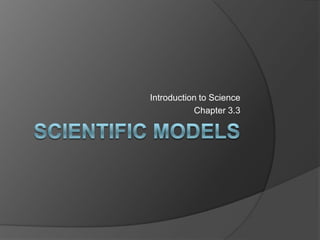Introduction to Science 3.3 : Scientific Models
•Descargar como PPTX, PDF•
4 recomendaciones•7,409 vistas
Denunciar
Compartir
Denunciar
Compartir

Recomendados
Recomendados
Más contenido relacionado
La actualidad más candente
La actualidad más candente (20)
Physical Science Chapter 1.1 What is Physical Science?

Physical Science Chapter 1.1 What is Physical Science?
Destacado
Destacado (20)
Computational Thinking in the Workforce and Next Generation Science Standards...

Computational Thinking in the Workforce and Next Generation Science Standards...
Similar a Introduction to Science 3.3 : Scientific Models
Similar a Introduction to Science 3.3 : Scientific Models (20)
The TermsMany terms mean different things in our common language a.docx

The TermsMany terms mean different things in our common language a.docx
Más de Chris Foltz
Más de Chris Foltz (20)
Earth Science 3.3 : Absolute Dating: A Measure of Time

Earth Science 3.3 : Absolute Dating: A Measure of Time
Último
APM Welcome, APM North West Network Conference, Synergies Across Sectors

APM Welcome, APM North West Network Conference, Synergies Across SectorsAssociation for Project Management
Mattingly "AI & Prompt Design: Structured Data, Assistants, & RAG"

Mattingly "AI & Prompt Design: Structured Data, Assistants, & RAG"National Information Standards Organization (NISO)
Último (20)
Separation of Lanthanides/ Lanthanides and Actinides

Separation of Lanthanides/ Lanthanides and Actinides
Measures of Dispersion and Variability: Range, QD, AD and SD

Measures of Dispersion and Variability: Range, QD, AD and SD
Kisan Call Centre - To harness potential of ICT in Agriculture by answer farm...

Kisan Call Centre - To harness potential of ICT in Agriculture by answer farm...
APM Welcome, APM North West Network Conference, Synergies Across Sectors

APM Welcome, APM North West Network Conference, Synergies Across Sectors
Web & Social Media Analytics Previous Year Question Paper.pdf

Web & Social Media Analytics Previous Year Question Paper.pdf
Beyond the EU: DORA and NIS 2 Directive's Global Impact

Beyond the EU: DORA and NIS 2 Directive's Global Impact
Call Girls in Dwarka Mor Delhi Contact Us 9654467111

Call Girls in Dwarka Mor Delhi Contact Us 9654467111
Mattingly "AI & Prompt Design: Structured Data, Assistants, & RAG"

Mattingly "AI & Prompt Design: Structured Data, Assistants, & RAG"
Russian Call Girls in Andheri Airport Mumbai WhatsApp 9167673311 💞 Full Nigh...

Russian Call Girls in Andheri Airport Mumbai WhatsApp 9167673311 💞 Full Nigh...
Measures of Central Tendency: Mean, Median and Mode

Measures of Central Tendency: Mean, Median and Mode
Introduction to Science 3.3 : Scientific Models
- 1. Scientific Models Introduction to Science Chapter 3.3
- 2. Objectives: Explain how models are used to represent the natural world. Identifythree types of scientific models. Describe theories and laws. Bellringer: To teach cardiopulmonary resuscitation (CPR), instructors often use a mannequin to model a human upper torso and head. Why do you think CPR is taught with a model instead of a real human? Would the class be as effective if a model were not used?
- 3. Types of Models Model A representation of an object or a system. Physical Models look like they thing they represent. For example, the model flower shown at right can be used to learn the parts of a real flower.
- 4. Mathematical Models Made up of mathematical equations and data. The weather map shown below is a mathematical model. Conceptual Models Systems of ideas or are based on making comparisons with familiar things to explain an idea. Explains the origin of the universe
- 5. Models are just the right size Often used to represent things that are very small or very large. Useful for studying cells and particles of matter that are too small to see with the unaided eye. Also useful for studying objects that are too large to see completely such as the Earth or the solar system.
- 6. Models build scientific knowledge Often used to help illustrate and explain scientific theories. Theory Unifying explanation for a broad range of hypotheses and observations that have been supported by testing. Theories and models can change as new observations are made. Charles Darwin’s Theory of Evolution 1897 Model of Atom Current Model of Atom
- 7. Scientific Laws Formed when a theory and its models correctly predict the results of many different experiments. Law is defined as: A summary of many experimental results and observations. Laws are not the same as theories. Laws tell you only what happens, not why it happens.